
Lee Jae-Woong, one of the three founders of Daum Communications (now Kakao) that provides web services (Source: forbesvietnam.com.vn)
Vietnamese startups are expected to have more opportunities to receive investment and support from Korean investors, who are coming in droves in Vietnam, experts have said.
“It is Vietnam’s turn to have new unicorns,” Korean investor Lee Jae-Woong told the Forbes Vietnam Tech Summit 2019 in mid-March, referring to local startup companies.
The Republic of Korea (RoK) industrialised in the 1960s, developed information technology in the 2000s, and is now entering the Fourth Industrial Revolution, said Lee, one of the three founders of Daum Communications (now Kakao) that provides web services.
Vietnam has all three conditions, which is perfect for breakthrough growth, he said, highlighting the country’s infrastructure, good labour force and government support as other facilitators.
Nguyen Hoang Hai, CEO of Canavi, a startup that specialises in job placements for women, said Korean investors are showing great interest in Vietnam.
Currently, the RoK is Vietnam’s biggest foreign direct investment (FDI) supplier, he said, adding that apart from investors, startups from the East Asian country have also considered Vietnam a promising place to expand.
Hai took the example of the opening of a representative office in Vietnam earlier this year of Rehoboth Business Incubator, which was formed in 1998 and now has a network of 59 business centres in the RoK.
Woowa Brothers - operator of the RoK’s leading food delivery platform Baedal Minjok - has also acquired Vietnam’s food delivery company Vietnammm, according to the CEO.
Hai attributed the Vietnamese market’s attractiveness to favourable visa procedures and positive impacts of cultural exchanges between the two countries as well as promotion programmes between Vietnamese startups and RoK investors.
This year is expected to see tough competition among investors, especially those from foreign countries, who want to invest in quality Vietnamese startups, he said.
According to the Korea Trade-Investment Promotion Agency (KOTRA), Korean investors are attracted by Vietnam’s consumer market of more than 96 million people.
In the past, investment has mainly went to services, retail, electronics, finance, banking and insurance in Vietnam. In 2019, the fashion sector is expected to become a new magnet for investors.
The abundant, hardworking and skillful workforce, and political stability are also Vietnam’s advantages, other experts said.
However, local startups need consultations to map out specific operational orientations, they noted, suggesting stronger connectivity in the domestic innovative ecosystem to help startups.
Global economic integration helps Vietnam expand agri-products markets
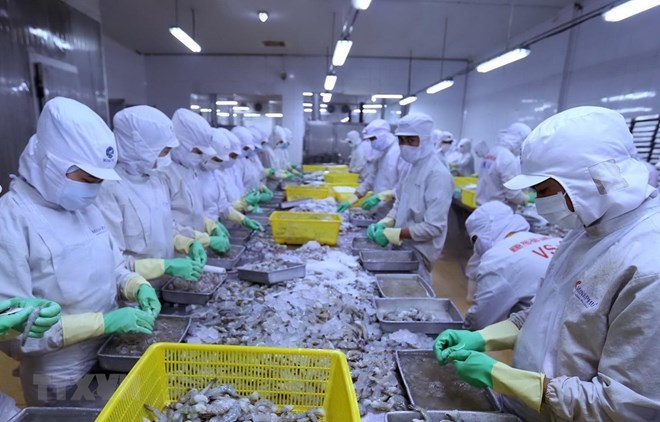
An export shrimp processing line in Vietnam
Vietnamese agro-forestry-fishery products are now available in 180 countries and territories thanks to Vietnam’s increasing global economic integration and implementation of free trade agreements.
Economic integration has helped Vietnamese agri-products overcome tariff barriers, especially staples such as rice and aquatic and wood products.
The Comprehensive and Progressive Agreement for Trans-Pacific Partnership (CPTPP) has created excellent opportunities for Vietnamese agri-products to join global supply chains, according to deputy head of the Agro Processing Market Development Authority (AgroTrade) Tran Van Cong.
It also creates a driver as well as pressure on domestic businesses to increase exports of processed products with high added values, he added.
According to Nguyen Ton Quyen, Vice Chairman of the Vietnam Timber and Forest Product Association, other members of the CPTPP are potential export markets of the Vietnamese wood industry.
The Forest Law Enforcement, Governance and Trade Voluntary Partnership Agreement (FLEGT-VPA) between Vietnam and the EU is expected to promote export growth of wood and timber products to major European markets.
Deputy Minister of Agriculture and Rural Development Ha Cong Tuan said EU is the fourth biggest market of Vietnam, making up 13-17 percent of the country’s furniture export turnover.
Not only creating opportunities in trade of goods, integration has enabled the agriculture sector to promote the application of science and technology to improve production quality, competitiveness, technical standards and food safety and hygiene.
Many advanced technical standards including Vietnamese Good Agricultural Practices (VietGAP), ISO and HACCP in processing have been applied in Vietnam. National standards on food safety and animal and plant quarantine have been harmonised with international standards, helping the country’s’ farm produce penetrate choosy markets.
The Ministry of Agriculture and Rural Development has focused on developing foreign markets, prioritising those with high export turnover, while removing barriers for export businesses and providing information on Vietnamese farm produce and production procedures to foreign customers to reinforce their trust.
Last year, the ministry spared no effort to remove difficulties for businesses in the two major markets of China and the EU.
The ministry sent working delegations to China and hosted and participated in trade promotion activities to introduce Vietnamese agri-products.
In the EU, the ministry helped businesses increase the presence of Vietnamese farm produce at supermarkets.
It also held activities to promote trade of Vietnamese farm produce in Russia, Japan, India and ASEAN countries.
HDBank targets profits up 27 percent in 2019
The Ho Chi Minh City Development Joint Stock Commercial Bank (HDBank) plans to collect 5.07 trillion VND (217 million USD) in pre-tax profits this year, an increase of 27 percent compared to 2018.
The information was released during HDBank’s Annual General Meeting of Shareholders (AGM) 2019 held in HCM City on April 23.
The bank forecast that total assets this year will be up 16 percent from 2018 to reach nearly 250 trillion VND (10.73 billion USD), capital mobilisation will touch 224.2 trillion VND (9.62 billion USD), an increase of 20 percent year-on-year.
In 2019, outstanding loans are expected to be 160.9 trillion VND (6.9 billion USD), bad debt ratio will be kept below 2 percent.
Return on Asset (ROA) and Return on Equity (ROE) will increase by 1.7 percent and 21.2 percent, respectively.
The bank will continue to expand the network of transaction points, lifting the total number to 308.
In 2019, HDBank will apply modern banking management models to meet international standards, boost technological innovation and apply Basel II standards in risk management, improve financial capacity and competitiveness, diversify mobilised capital sources and restructure assets to increase the proportion of profitable assets.
This year, shareholders will receive cash dividend payment at the rate of 10 percent.
During the AGM, shareholders also agreed with the plan to increase charter capital in 2019 via the issuance of shares for dividend payment and bonus shares. Dividend paid in shares and bonus shares issuance will be kept at the rate of 20 percent.
This capital raising plan will help HDBank to further improve the safety criteria under Basel II and increase capital supply for business activities.
Last year, HDBank witnessed strong development as most of the business targets increased positively compared to the same period of 2017.
Total assets reached more than 216 trillion VND (9.27 billion USD), up 14.1 percent. Owner's equity reached 16.8 trillion VND (721.24 million USD), up 14 percent. Total outstanding loans reached 129.6 trillion VND (5.56 billion USD), up 17.8 percent.
Total mobilised capital reached 186.7 trillion VND (8.01 billion USD), an increase of 9.5 percent compared to 2017. Of the estimate, mobilised capital from residents and economic organisations reached 143 trillion VND (6.13 billion USD). Non-performing loan (NPL) ratio was controlled at low level of 1.5 percent. Capital adequacy ratio (CAR) reached 12.1 percent.
In 2018, HDBank’s pre-tax profit was 4 trillion VND (171.73 million USD), up 65.7 percent compared to 2017 and completing 101.8 percent of the annual plan.
With improvement in operating efficiency, HDBank continued to maintain growth in net profit. Within five years from 2013 to 2018, HDBank's net profit growth reached 67.1 percent. As a result, earnings per share (EPS) also increased by nearly 50 percent on average.
By the end of 2018, HDBank had completed opening 40 transaction points and five branches, increasing the network system to 285 units. The system of consumer financial transaction points continued to be expanded to 13,825 points, maintaining the market leading position. The number of employees reached 14,340 people, with increasing income.
In 2018, HDBank shares were officially listed and traded on the Ho Chi Minh Stock Exchange (HOSE). The bank was also included in the list of Vietnam’s top 20 enterprises with the largest market capitalisation. Also last year, HDBank shares met all the conditions to join the VN-30 Index basket.
SHB plans to raise charter capital to over 17.57 trillion VND
The Saigon-Hanoi Commercial Joint Stock Bank (SHB) has a plan to increase its charter capital by over 5.53 trillion VND (237.48 million USD) to more than 17.57 trillion VND (754.5 million USD) via public offering of shares and paying dividends in the form of additional stocks.
At the bank’s annual shareholder meeting in Hanoi on April 23, Director General Nguyen Van Le said that share issuance is important to the bank to improve its competitive capacity in the context of global economic integration.
SHB will issue some 252.6 million shares valued at 2.52 trillion VND (108.2 million USD) to pay dividends in 2017 and 2018, and offer nearly 300.8 million bonus shares to its existing shareholders in the proportion of 4:1, which means an investor can buy one extra share for every four shares already held by him or her.
Regarding the use of additional charter capital, Le said that some 850 billion VND (36.5 million USD) will be set aside to develop the bank’s information technology system and fixed assets for expanding business network. Meanwhile, the remainder will be used to scale up its lending activities.
At the meeting, SHB also submitted its plan to increase its presence in the Ivory Coast through setting up a branch or a joint-venture to meet capital demand of Vietnamese enterprises, who are increasing investments in the country.
In 2019, SHB targets a place in top five largest commercial banks in Vietnam in terms of total assets. The bank expects its before-tax profit at over 3 trillion VND (128.76 million USD), up 47 percent from 2018; capital mobilisation at 283.9 trillion VND (12.19 billion USD), rising 16.6 percent; and outstanding debt at 261.59 trillion VND (11.23 billion USD), growing 13 percent.
The dividend payout ratio will be 11 percent this year.
Binh Duong, Dong Nai expect higher growth in wood exports with CPTPP
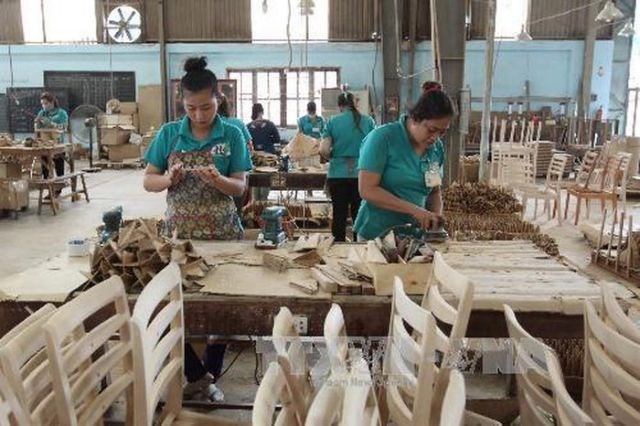
The southern provinces of Binh Duong and Dong Nai, which have the highest export growth rate and number of businesses in the wooden products sector, are poised to take advantage of the benefits of the Comprehensive and Progressive Agreement for Trans-Pacific Partnership (CPTPP).
The province has around 1,215 wood processing businesses, with 905 of them domestic firms with 10.8 trillion VND (469.6 million USD) of registered capital, and 310 foreign companies with a total of 2.3 billion USD, according to Binh Duong’s Department of Industry and Trade.
More than 250,000 employees work in the industry, and of that number, 40-45 percent of them are seasonal.
Last year, total export turnover from forestry and wood products in Vietnam was over 9.3 billion USD. The industry had the highest surplus export value in Binh Duong province.
Phan Van Binh, Chairman of the Dong Nai Wood and Craft Association, said the province’s wood exports at the beginning of 2019 were 10 percent higher than the same period last year.
Exports for this year are expected to be 12-15 percent higher than 2018, which was nearly 1.4 billion USD.
Many businesses in the industry have been successful in finding partners and forming contracts for the year, he added.
Dien Quang Hiep, Chairman of the Binh Duong Furniture Association, said the CPTPP has opened up new markets and opportunities for Vietnam’s wood industry.
The partnership can reduce the industry’s reliance on markets such as the US and Europe, and help businesses further penetrate markets such as Japan and Canada.
However, experts have said that businesses need to work on improving their workforce, and thus productivity and product quality.
More high quality materials (rubber wood and acacia wood) are needed for production as well as raw material exports. Trade facilitation also needs to be improved.
Vietnam’s forestry exports in the first four months of the year totalled 3.28 billion USD, 17.8 percent higher than in 2018.
The industry’s main markets are the US, Japan, the EU, China and the Republic of Korea.
Changing management thinking to boost businesses
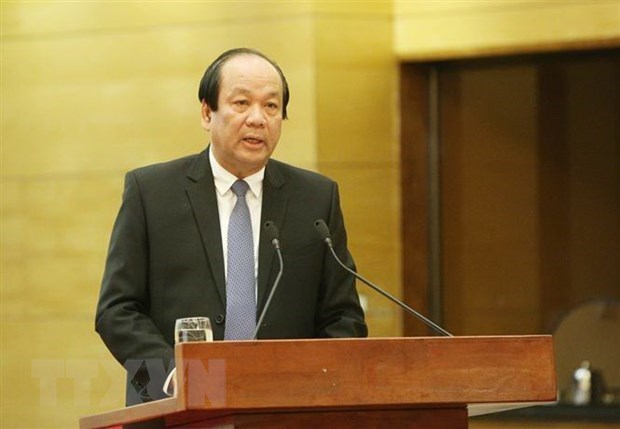
Minister-Chairman of the Government Office Mai Tien Dung
It was critical to change management thinking towards removing difficulties and creating favourable conditions for businesses, Mai Tien Dung, Minister-Chairman of the Government Office stressed at the meeting of the Prime Minister’s working group with six ministries on April 22.
Still, simplifying procedures would not mean that management would be loosened, he stressed, adding that opinions from different perspectives must be heard to at the same time to ensure benefits of businesses, ensure growth targets, ensure the community’s benefits and the State management goals.
At the working session, 43 proposals of businesses were discussed and would be reported to the Government at the earliest meeting. Most discussed was regulations related to the management of alcohol businesses.
Regarding the Vietnam Beer Alcohol Beverage Association’s proposal about removing the ban on selling wine online, Deputy Minister of Industry and Trade Dang Hoang An said that the control over quality of products online remained difficult.
An said that it was necessary to have strict regulations of managing the sale of alcohol products on the internet.
Dung said that the National Assembly was considering the association’s proposal when reviewing the draft law on alcohol harm prevention, adding that the aim was to create favourable conditions for businesses but still ensure efficient management.
With regard to the association’s proposal of abolishing the licence for the sale of alcohol at five-star hotels, Dung said that if the licence was not necessary, it should be removed.
“We need to change the management thinking. The management should be shift from pre-check to post-check,” Dung said. “We could not ban or develop more prerequisites or procedures for businesses which are difficult to manage.”
Deputy Minister of Health Le Quang Cuong agreed, adding that it was necessary to invoke strict punishments to prevent violations and enhance inspection over the operation of alcohol businesses.
Dung said that Vietnam showed determination to create breakthroughs for growth this year, adding the Government would always listen to opinions from businesses and associations for more thorough and effective reforms.
He also asked for more efforts to enhance administrative reforms, removing barriers for businesses as well as wipe out legal gaps which State officials could take advantage of to cause difficulties to firms. In additions, cutting costs for firms was also important, Dung added.
Dong Nai province calls for infrastructure investment of US$1.2 billion
The government of Dong Nai has announced a list of 12 infrastructure projects, worth a total of US$1.2 billion, that the southern province is calling for investment in.
Six projects, worth US$410 million, belong to road and bridge development while the remainder concern water drainage and wastewater treatment, costing a total of US$806 million.
Dong Nai is planning to construct a 15-km road to connect sea ports in Nhon Trach district at a cost of US$235 million and also a US$50 million road between Trang Bom and Xuan Loc with a length of 50 kilometres.
Other road projects include a 24-kilometre road from Cam My district centre to National Highway 1A, a 6-kilometre road to Phuoc An Port and a 2.4-kilometre road section connecting Buu Hoa Bridge with National Highway K1.
The Thong Nhat Bridge and its approach roads are also under consideration for development, with an estimated cost of US$45 million for the project.
Dong Nai is also looking for investment in two water drainage and wastewater treatment projects in the provincial capital city of Bien Hoa and another four projects in other towns and districts.
These 12 projects are expected to boost the province’s socio-economic development and help with local environmental protection.
VIMO & Hanoi Railways sign ticketing deal
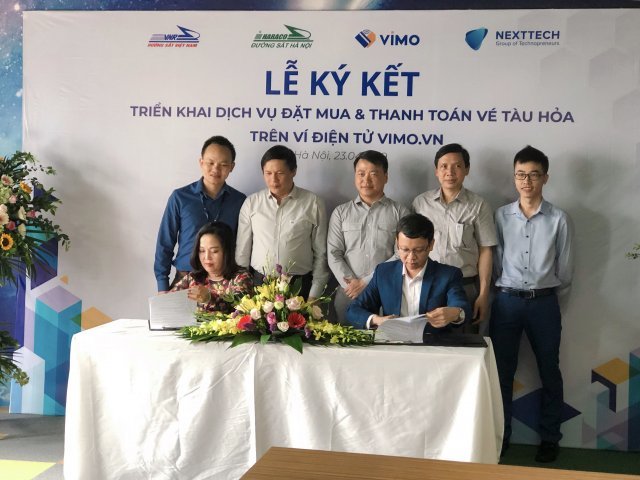
One of the leading mobile payment platforms in Vietnam, VIMO, signed a cooperative deal with the Hanoi Railway Transport JSC (HARACO) to introduce train ticket booking and payment services via the VIMO.vn e-wallet.
In just two minutes on the VIMO e-wallet app, passengers can book train tickets, choose the seat type, make the payment, and receive their tickets.
Booking train tickets on a mobile app brings many advantages to passengers, as they do not need to go to a train station or travel agent or go through many steps on a website.
Passengers need only download the VIMO e-wallet app on iOS or Android and follow the instructions on the screen. To pay for train tickets, they need payment cards such as Visa, Master Card, JCB or ATM cards of more than 20 banks linked to payments on VIMO e-wallets.
Ms. Phung Thi Ly Ha, Deputy General Director of HARACO, said the cooperative deal with VIMO is in line with development trends in e-commerce and within plans to diversify ticketing forms, develop HARACO’s sales channels, and help customers buy tickets anytime, anywhere. “The biggest advantage is the fast access and easy steps, so the purchase of tickets and payment on mobile apps provide convenience,” she said. She told VET that HARACO expects train ticket payments via e-wallet to contribute significantly to the company’s total revenue.
Mr. Do Cong Dien, General Director of VIMO, said that 2018 saw a leap in the growth of e-commerce and the habit of using new payment technologies. “With this cooperation, VIMO hopes to bring safe, convenient and quick payment methods to customers, contributing to promoting the implementation of the government’s non-cash payment development project,” he said.
To mark the launch of the new service, from April 23 to May 31, VIMO and HARACO are offering a promotional program for all passengers, with 50 per cent off tickets to a maximum of VND200,000 ($9) for the first 1,000 customers booking tickets via VIMO e-wallet.
GrabTaxi to hit the road in three more provinces
Vietnam’s Ministry of Transport has approved ride-hailing firm Grab to run taxi services in three more provinces.
GrabTaxi has been cleared to operate in the central province of Thanh Hoa, the southern province of An Giang and the Central Highlands province of Dak Nong.
It currently functions in five localities - Ha Noi, Ho Chi Minh City, Da Nang, the northern province of Quang Ninh and the central province of Khanh Hoa.
In June last year, the ministry had blocked GrabTaxi's plan to extend its services to provinces like Ninh Thuan, Dong Thap and Gia Lai. Grab Vietnam had asserted then that GrabTaxi was an app for an e-commerce platform, so its operations would be in accordance with the government’s e-commerce laws.
The latest permission does not extend to GrabCar. Both GrabTaxi and GrabCar operate under the same Grab application, but GrabTaxi offers a run-of-the mill taxi service, while GrabCar is a service which connects customers with private cars.
Grab is the leading ride-hailing company in Vietnam. Last year, it acquired Uber in Southeast Asia in return for a 27.5 percent stake.
Dung Quat refinery earns $26m in Q1 post-tax profit
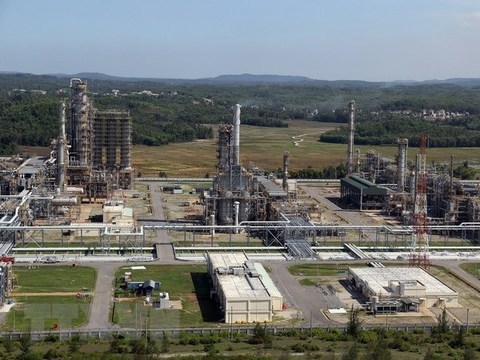
A view of the Dung Quat oil refinery.
The Dung Quat oil refinery, based in the central province of Quang Ngai, exceeded its designed capacity by 7 per cent in the first quarter of 2019, helping it gain over VND606 billion (US$26 million) in post-tax profit during the period.
In Q1, the factory turned out more than 1.7 million tonnes of products and earned over VND23.05 trillion in revenue. It contributed some VND2.44 trillion to the State budget, according to the financial report for Q1 of the Binh Son Refining and Petrochemical JSC (BSR) – a member of the State-owned Vietnam Oil and Gas Group and the operator of the refinery.
The BSR said global crude oil prices fluctuated unpredictably from Q4 of 2018 through February this year. Facing that fact, the company took many drastic and timely measures, including aligning the Dung Quat refinery’s operations with the market, promoting marketing activities, and boosting energy and technology optimisation solutions.
As a result, its profit in Q1 improved considerably compared to the previous quarter.
To achieve this year’s targets, the BSR will continue working to ensure its factory operates safely and stably and at 105-107 per cent of the designed capacity.
South Korean firms explore investment opportunities in VN
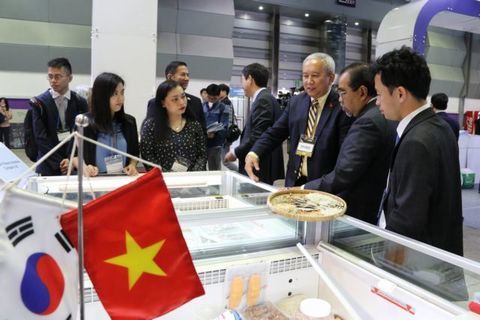
A Vietnamese seafood company showcase its products at the three-day Seoul International Seafood Show 2019 which is taking place in Seoul from Monday. A number of Korean firms are expecting to increase investment in Viet Nam.
Firms from the Republic of Korea (RoK) were expecting to increase investments in information technology, biotechnology, food processing and part-supplying industry in Viet Nam, attendees were told at a conference on Monday in Ha Noi.
The Viet Nam Trade Promotion Agency under the Ministry of Industry and Trade in collaboration with the Korea Federation of Small and Medium Businesses organised the trade and investment promotion conference themed: “Opportunity for Business Development” which attracted more than 150 firms from the two countries.
Experts said at the conference that Korean firms were showing significant interests in investing in IT, biotechnology, food processing and part-supplying industry in Viet Nam, together with recreation and culture sectors.
According to Ju Young Seob, RoK’s former Minister of Small and Medium Sized Enterprises and Startups, the free trade agreement between RoK and Viet Nam which came into force on December 20, 2015 created impetus to leverage the bilateral trade to US$100 billion by 2020.
However, companies from the two countries needed to enhance co-operation and expand trade and investment to third countries so as to reach that goal, he said.
“We believe with the determination of the two Governments and the dynamism of businesses, the economic cooperation between Rok and Viet Nam will see breakthroughs in the future,” he stressed.
Speaking at the conference, Vu Ba Phu, Director of the Viet Nam Trade Promotion Agency, said that more Korean firms were expected to expand investment in Viet Nam, adding that the Viet Nam Trade Promotion Agency committed to provide support for foreign investors in general and Korean investors in particular to invest in the country.
The two countries established diplomatic relations in 1992.
Over the past 27 years, RoK became the third largest trade partner of Viet Nam, accounting for 20.4 per cent of Viet Nam’s trade value in 2018.
Regarding foreign direct investment (FDI), RoK was the biggest investor in Viet Nam, Phu said, adding that as of February, Korean investors pledged to invest a sum worth $63.7 billion in Viet Nam, making up for 18.5 per cent of the total registered FDI into Viet Nam.
Phu also said that there were around 7,000 Korean firms operating in Viet Nam, providing jobs for more than 700,000 workers and contributing around 30 per cent to Viet Nam’s export value.
The operation of Korean firms such as Samsung, LG, Doosan, Hyundai and Posco in Viet Nam also helped promote the development of Viet Nam’s part-supplying industry, Phu said.
Binh Duong, Dong Nai expect higher growth in wood products with CPTPP

Wood processing in Binh Duong Province.
Binh Duong and Dong Nai provinces, which have the highest export growth rate and number of businesses in the wooden products sector, are poised to take advantage of the benefits of the Comprehensive and Progressive Agreement for Trans-Pacific Partnership (CPTPP).
The province has around 1,215 wood processing businesses, with 905 of them domestic firms with VND10.8 trillion (US$469.6 million) of registered funds, and 310 foreign companies with a total of US$2.3 billion, according to Binh Duong’s Department of Industry and Trade.
More than 250,000 employees work in the industry, and of that number, 40-45 per cent of them are seasonal.
Last year, total export turnover from forestry and wood products in Viet Nam was over $9.3 billion. The industry had the highest surplus export value in Binh Duong Province.
Phan Van Binh, chairman of the Dong Nai Wood and Craft Association, said the province’s wood exports at the beginning of 2019 were 10 per cent higher than the same period last year.
Exports for this year are expected to be 12 – 15 per cent higher than 2018, which was nearly $1.4 billion.
Many businesses in the industry have been successful in finding partners and forming contracts for the year, he added.
Dien Quang Hiep, chairman of the Binh Duong Furniture Association, said the Comprehensive and Progressive Agreement for Trans-Pacific Partnership has opened up new markets and opportunities for Viet Nam’s wood industry.
The partnership can reduce the industry’s reliance on markets such as the US and Europe, and help businesses further penetrate markets such as Japan and Canada.
However, experts have said that businesses need to work on improving their workforce, and thus productivity and product quality.
More high quality materials (rubberwood and acacia wood) are needed for production as well as raw material exports. Trade facilitation also needs to be improved.
Viet Nam’s forestry exports in the first four months of the year totalled $3.28 billion, 17.8 per cent higher than in 2018.
The industry’s main markets are the US, Japan, the EU, China and South Korea.
Kiên Giang district expands two-stage industrial shrimp farming
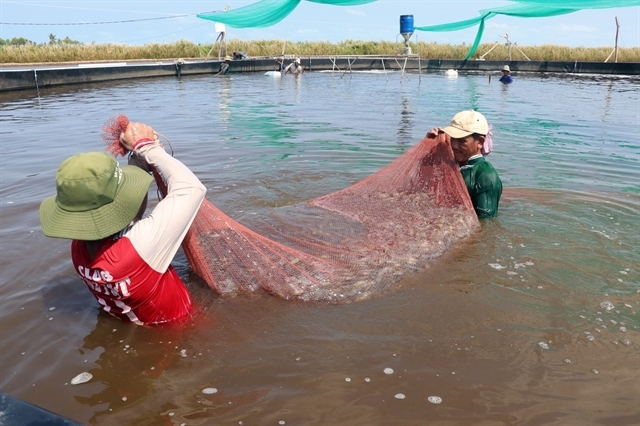
Farmers harvest white-legged shrimp bred under the two-stage industrial farming model in Kiên Giang Province’s An Minh District.
An Minh District in Kiên Giang Province is expanding a two-stage industrial farming model to breed white-legged shrimp which offers high incomes to farmers and protects the environment.
It involves breeding the shrimp are in round-shaped ponds covered with anti-sunshine nets and plastic sheets on their beds in a two - stage model.
In the first, shrimp fry are bred in a nursery for a period of 25 – 30 days, and in the second, they are transferred to the main pond at a density of up to 450 creatures per square metre.
They are raised based on Vietnamese good agricultural practice (VietGAP) standards.
Lê Văn Khanh, head of the An Minh District Agriculture and Rural Development Bureau, said the model has been developed in the district for two years, and it offers a new advanced farming model to adapt to climate change.
“[It] is safer and more effective and sustainable compared to industrial farming in soil ponds.”
There are 15 households in the district farming white-legged shrimp using the model, according to the bureau.
They are instructed by agricultural officials to regularly replace the water in the ponds and check water quality and colour to ensure the sustainable growth of the animals and protect the environmental.
The households are also taught how to equip their ponds, treat water and waste and select shrimp fry and food for them.
The crustaceans bred under the model have a survival rate of 90 per cent and a yield of 50 tonnes per hectare per year.
Farmers can breed three to four crops a year using the model. Each crop lasts 60 – 70 days.
Nguyễn Văn Suồi, a farmer in the district’s Vân Khánh Đông Commune, said he breeds shrimp in five 500sq.m ponds and earns VNĐ70 million (US$3,000) from each per crop.
The model offers higher incomes than extensive farming or rotating between shrimp and rice in the same field, he said.
With its advantages like being on the coast, An Minh has excellent conditions for aquaculture, including shrimp farming.
But most shrimp farming here is done using the shrimp–rice model, and yields are not high.
Khanh said the district plans to expand the industrial and semi-industrial shrimp farming models to more than 100ha by next year, focusing on the two-stage industrial farming model.
But it requires large sums of investment while farmers lack the experience to implement the model, he said.
The cost of setting up a 500sq.m pond is VNĐ170 – 180 million ($7,310 – 7,740).
To develop the model, the bureau would offer training to more famers and help them get loans by petitioning the province and district, Khanh added.
Hanoi lures investment in nine hi-tech agricultural parks
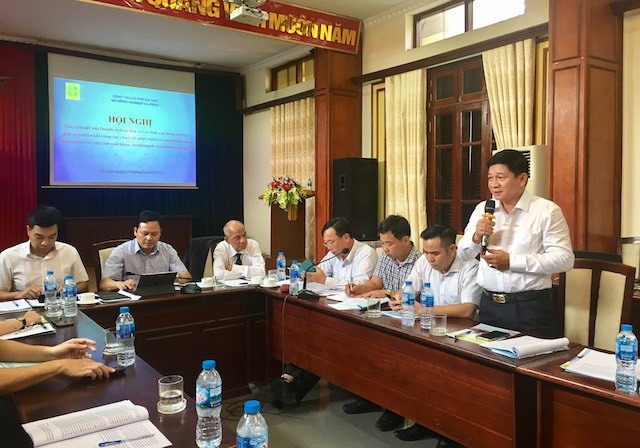
Hanoi with a population of nearly 10 million would consume huge amounts of food, said Ta Van Tuong, vice director of the department at a meeting held on April 22.
According to Tuong, the locals would consume in average 83,400 tons of rice, 20,000 tons of pork, 5,230 tons of beef, 5,200 tons of chicken, 5,050 tons of seafood, 84,100 tons of vegetables, 95 million eggs and 52,000 tons of fruits per month.
However, the production capacity in Hanoi has not been able to meet local demans, as the city currently provides 60% of the demand for pork and chicken, 65% for vegetables, 66% for eggs, and imports the remaining, Tuong added.
For some specific foodstuffs, consumption demand remains huge while local suppliers have only met 35% of the demand for rice, 15% of beef, 40% of seafood, 25% of processing food and 30% of safe fruits, among others.
As of present, the city mostly imports a big chunk of agricultural products from neighboring cities and provinces.
Tuong said Hanoi is an opportunity for investors given its large-scale market. Over the past few years, the local authority has put measures in place to promote investments in agriculture, developing a supply chain for clean and safe farm produce.
In Hanoi, there are a total of 123 hi-tech agricultural production models applying hi-tech, 121 safe supply chain for safe and clean farm products and 40 agricultural products under brand protection.
Tuong stated enterprises play a key role in agricultural development, for which the city would create the best conditions to support enterprises in doing business.
For sustainable consumption of agricultural products, Tuong said it is important for farmers to apply hi-tech in production, ensuring food quality and safety standards for both local consumption and export.
In the coming time, Hanoi’s Rural and Agricultural Development Department would cooperate with the Hanoi Small and Medium Enterprises Association (HanoiSME) and the Business Association of Overseas Vietnamese (BAOOV) to support enterprises investing in agricultural sectors.
Currently, Hanoi has nine hi-tech agricultural parks with a combined area of 300 hectares in Hoai Duc district, 76 hectares in Ha Dong district, 105 hectares in Me Linh district, 33 hectares in Dan Phuong district, 200 hectares in Phuc Tho district, 70 hectares in Soc Son, 300 hectares in Ba Vi and 80 hectares in Son Tay.
Agro-forestry-fishery exports fetch $12.4 billion in four months
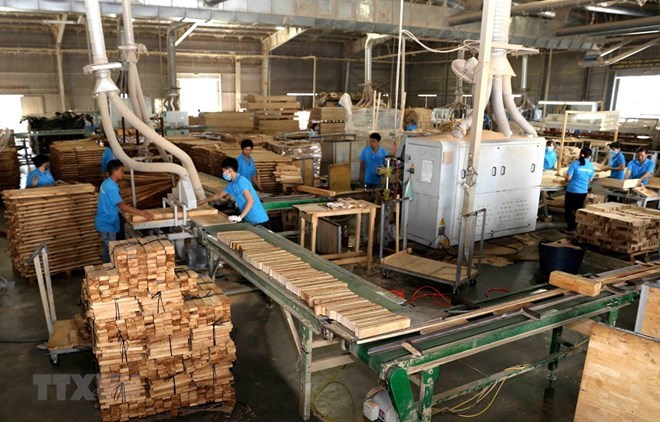
Export revenues of agro-forestry-fishery products in April is estimated to hit 3.5 billion USD, pushing the figure in the first four months of this year to 12.4 billion USD, equivalent to the figure recorded in the same period last year, reported the Ministry of Agriculture and Rural Development.
In April, export revenues of farm produce is likely to hit 1.5 billion USD, while that of aquatic products was estimated at 694 million USD, and livestock reached 46 million USD.
Meanwhile, earnings from forestry products and furniture are estimated at 875 million USD in the month and 3.27 billion USD in the first four months, up 17.8 percent year on year, resulting in a trade surplus of nearly 2.49 billion USD for the forestry sector.
Key markets for Vietnamese forestry products include the US, Japan, the EU, China and the Republic of Korea, which together consume 87 percent of the products.
Impressive export revenues were seen in rubber (559 million USD), tea (62 million USD), fruits and vegetables (1.4 billion USD), cashew nuts (922 million USD) and peppercorn (288 million USD).
At the same time, exports of aquatic products in April are likely to reach 2.48 billion USD, up 2.4 percent, including 635 million USD from tra fish and 913 million USD from shrimps.
On the contrary, falls in both export volume and value look set to be recorded in rice, coffee, cassava and cassava products. Export volume of rice dropped 8 percent and value was down 19 percent, while the respective fall of coffee were 13 percent and 19 percent, and cassava and cassava products were 14 percent and 3.3 percent.
In the month, Vietnam imported 2.68 billion USD worth of agro-forestry-fishery products and agricultural materials, raising total imports in the four months to 9.7 billion USD, up 3.2 percent year on year.
In the first four months of this year, 46,000 hectares of forests were planted, a year-on-year rise of 1.72 percent. Timber production reached 6.23 million cubic metres, up 4.4 percent year on year.
In the period, the country collected 755.24 billion VND in forest environment service fees, up 9 percent against the same period last year and 23.6 percent of the yearly target.
More than 35 million tonnes of cement sold in four months
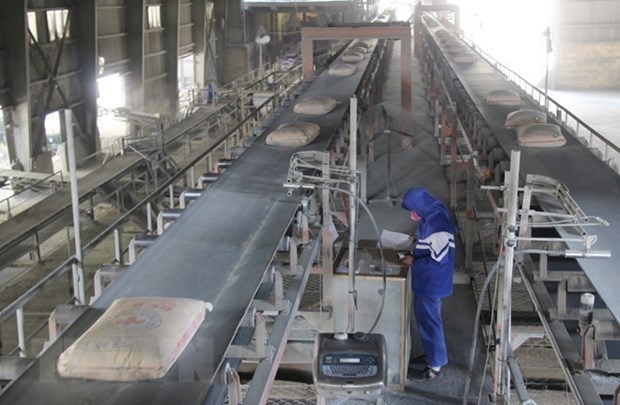
Vietnam sold more than 35 million tonnes of cement at home and abroad in the January-April period, up 8 percent year on year.
According to the Construction Ministry’s Department of Construction Materials, total cement consumption is estimated to hit 9.18 million tonnes in April, equivalent to the same period last year.
Of the figure, about 6.48 million tonnes were consumed on the domestic market, up 0.43 million tonnes month-on-month and up slightly year-on-year.
The Vietnam Cement Industry Corporation alone sold roughly 2.54 million tonnes in April and 8.42 million tonnes in the four months.
In the four months, some 21.65 million tonnes were sold domestically compared to the yearly target of 66-67 million tonnes.
Meanwhile, approximately 2.7 million tonnes were exported during April, down 0.7 million tonnes month-on-month and 2 percent year-on-year. However, four-month cement exports rose annually by 23 percent to about 13.8 million tonnes.
Cement prices in April remained stable compared to the same period last year.
Sector enhances ties with foreign partners to boost green growth
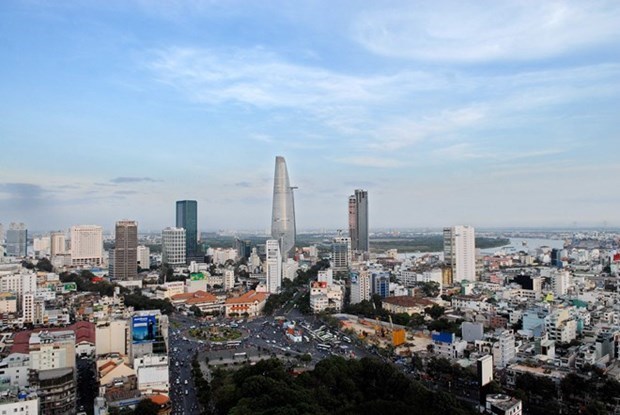
The construction sector aims that half of big- and medium-sized cities in Vietnam meet green city standards by 2030
Vietnam’s construction sector is enhancing cooperation with international partners to help promote green growth.
In its action plan on green growth, the construction sector aims that half of big- and medium-sized cities in Vietnam meet green city standards by 2030. This plan is part of efforts to realise the national green growth strategy.
Deputy Minister of Construction Phan Thi My Linh said although cities have been paying attention to green growth, boosting urban green growth is still a new issue in the country, and there remains a big gap between expectations and what has been achieved.
The construction sector consumes a lot of natural resources and energy while emitting a considerable volume of greenhouse gases. Therefore, short- and long-term solutions are necessary, as is cooperation with foreign partners to minimise its impacts on the environment, she said.
As one of the countries most vulnerable to climate change, Vietnam has been working to improve its technical infrastructure’s capacity for climate change response, produce environmentally friendly building materials, apply energy efficient solutions to buildings and reinforce houses to cope with natural disasters.
These are fields in which Vietnam has great demand for cooperation with foreign partners, said Pham Khanh Toan – Director of the Department for International Cooperation under the Ministry of Construction.
Among the ministry’s joint projects with foreign partners, a project on energy efficiency in the building sector was carried out from 2014 to 2017 as part of the USAID Vietnam Clean Energy Programme. It benefited Hanoi, Hai Phong, Da Nang, Ho Chi Minh City and Can Tho.
This project aimed to help save energy, reduce CO2 emissions, promote energy saving activities and support low-emission development.
Meanwhile, the Asian Development Bank (ADB) has provided technical and financial assistance for water service companies in Vietnam to build criteria for these services. It has also helped the country to design a decree on public-private partnership and implement an urban environment programme since 2012.
The ADB recognised Vietnam’s efforts and achievements in associating development with green growth.
It said Vietnam is experiencing rapid urbanisation, and most of its GDP is contributed by cities. However, urbanisation has yet to meet expectations while the country is highly susceptible to climate change.
Between 2016 and 2020, the bank has agreed to support Vietnam with 600 – 800 million USD for climate change response and green city development.
Deputy PM commits all possible support to Japanese firms
Deputy Prime Minister Vuong Dinh Hue has affirmed that the Vietnamese government and north central localities are ready to offer all possible support to Japanese partners to expand their business operations there.
He made the statement at the conference “Meeting Japan - North Central Region” co-hosted by the Vietnamese Foreign Ministry and the Japanese Embassy in Vietnam in the central province of Nghe An on April 25.
The event brought together Japanese Ambassador to Vietnam Kunio Umeda, over 150 delegates from Japanese organisations, localities and 50 enterprises; leaders of six north central provinces from Thanh Hoa to Thua Thien-Hue, Yen Bai province, and those from ministries and agencies.
Sandwiched between the northern and central key economic zones, the north central region is home to three airports, nine seaports, diverse forest resources, a marine-based economy and attractive tourism services.
In his speech, Hue expressed his delight that Japan has regained the top position in terms of investment in Vietnam over the past two years with 9.1 billion USD in 2017 and 8.6 billion USD in 2018.
The Vietnamese Party and State are devising a strategy to attract foreign direct investment with a vision to 2045, focusing on investment with foreign partners and switching FDI attraction to key projects with high value, suiting economic restructuring roadmap, he said.
He added that Japan’s supply of official development assistance (ODA) to Vietnam will be incorporated into mid-term investment plan for 2021-2025 to bring practical benefits to the community.
The Deputy PM expressed his belief that both sides hold potential for collaboration in infrastructure, agriculture, industry, energy, education, human resources and tourism.
Asserting that the attraction of FDI and ODA should not overlap each other in investment policy planning in the north central region and the East-West Economic corridor, Hue said localities and partners need to choose prioritized works of national and inter-regional scale for common benefits of the country and region.
Regional localities should be more creative to boost practical and effective ties with Japanese partners, meeting their demand to turn the north central region into an attractive destination for Japanese tourists and investors, he said.
The Deputy PM suggested that leaders and firms from six regional provinces should report difficulties to the government and legislature to improve the efficiency of capital use.
Ambassador Umeda, for his part, said Vietnam is tapping free trade agreements for sustainable development and the Comprehensive and Progressive Agreement for Trans-Pacific Partnership (CPTPP) is a successful symbol of bilateral economic, trade and investment ties.
Japan pays attention to north-south high-speed railway project and an expressway linking the north central with Laos’ Vientiane to enhance cooperation with Vietnamese localities, he said.
He suggested strengthening mutual trust and coordination in human resources training, high-tech agriculture, support industry, tourism, education-training, and labour.
Permanent Deputy Foreign Minister Bui Thanh Son said three working sessions at the event focused on infrastructure connectivity between regional localities and others in the East-West economic corridor.
According to the McKinsey report in September 2018, Vietnam was one of the 18 emerging economies with substantial progresses over the past five decades. In 2018, Vietnam’s gross domestic product expanded by 7.08 percent, a record in the past decade.
In 2018, Vietnam ranked fourth globally in terms of nominal GDP and 34th in purchasing power parity. Its national economic competitiveness moved up from the 60th out of 138 economies in 2016 to the 55th out of 137 while its business environment index rose to the 69th out of 190 economies from the 82nd.
Nearly 26,000 foreign-invested firms from 130 countries and territories are operating in Vietnam with a total committed capital of upwards 330 billion USD. The country has become one of the world’s workshops for electronics, apparels, footwear and mobile phones.
Tourist arrivals surpassed 15 million, up 1.9 times from 2015. Vietnam has also been voted as one of the leading destinations in Asia.
PM witnesses signing of deal between TH Group, Chinese partner
Prime Minister Nguyen Xuan Phuc on April 25 witnessed the signing of a Memorandum of Understanding on strategic cooperation in distributing dairy products between Vietnam’s TH Group and Wuxi Jinqiao International Food City, which owns the largest merchandise wholesale centre in China.
The activity was part of the PM’s visit to attend the second Belt and Road Forum for International Cooperation (BRF) in Beijing from April 25-27.
The signing ceremony was a step to realise economic cooperation policy between the two governments while opening up market expansion opportunities as the Protocol on exports of Vietnamese dairy products to China is scheduled to be signed.
TH Group is also one of the vanguard units that export products with below 80 percent of milk to China via official channels before the Protocol is inked.
It is also ready with solid foundation to distribute TH True Milk-branded food, farm produce, and especially dairy and organic products to key areas in China.